Norfolk Heritage Trail
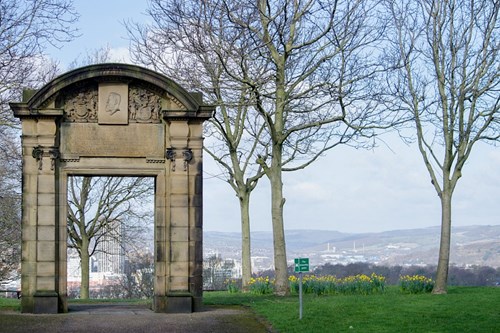
The Norfolk Heritage Trail is a walk through centuries of Sheffield history – from the middle ages to the modern, via the Tudors, Victorians and two world wars. The trail takes its name from the Dukes of Norfolk, who previously owned much of the land it covers, having inherited it from the Earls of Shrewsbury.
It starts at Sheffield Manor Lodge, which in Tudor times stood at the heart of a huge deer park; what’s left of the historical hilltop lodge today looks out over a bustling city centre. The trail heads downhill into this bustle, ending at Sheffield Cathedral.
Along the way it passes through quiet ancient woodland and the rolling green space of one of the country’s oldest public parks. It visits memorials and monuments, reminders of the epidemics and wars that have afflicted Sheffield over the centuries. It tells something of the city’s history of social housing, with quaint Victorian almshouses just around the corner from a postwar estate built out of concrete. Take it with you- you can access the guide as a PDF.
Distance: 3 miles
Duration: 1½ - 2 hours
Terrain: good footpaths, some steps, gentle descents
Start: 389 Manor Lane, S2 1UL
Alternative routes: the linear trail can be done in reverse or adapted into shorter walks – e.g. a short but steep walk uphill from Sheffield railway station to the Cholera Monument Grounds (5) will offer a great view of the city centre, taking in Shrewsbury Hospital (6), the Sweet Factory (7) and Park Hill (8) on the way up/down.
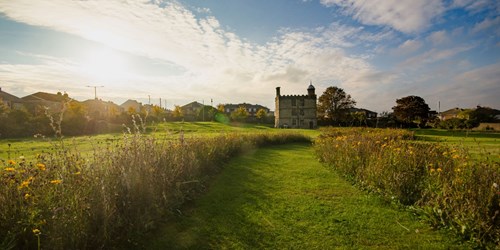
1. Manor Lodge
The Tudor ruin of Manor Lodge is wonderfully incongruous in its setting on the edge of a 20th century housing estate. Built around 1516, it was once a hunting lodge in the deer park and later became a stately home for the Lords of the Manor. Mary Queen of Scots spent time here in the 16th century, while she was in the captive custody of its owners George Talbot, 6th Earl of Shrewsbury, and Bess of Hardwick at the behest of Elizabeth I. There’s plenty for visitors to explore in and around Manor Lodge before setting off on the trail, including the turret house (the only part of the lodge that remains intact), the Discovery Centre, 1940s cottages, a lavender labyrinth, beautiful wildflower meadows and the Rhubarb Shed Cafe. Check the Manor Lodge website for opening times and to find out about events such as craft activities, history reenactments and more.
389 Manor Lane, S2 1UL
2. City Road Cemetery
Originally opened as Intake Road Cemetery in 1881 to serve the rapidly expanding industrial town, City Road Cemetery is now Sheffield’s biggest municipal cemetery at 100 acres. It’s also one of its most spectacular – with its gothic-style chapels, its Grade II listed gatehouse and clock tower, and a promenade that affords a panoramic view across the city. Before exiting through the impressive gatehouse, take a detour to the cemetery’s war memorials: one commemorates the Belgian troops and refugees who died in Sheffield during the first world war and another is dedicated to the memory of those who died in both world wars, while 134 civilian victims of the Sheffield blitz of 12 and 15 December 1940 rest in what has become known as the Blitz Garden.
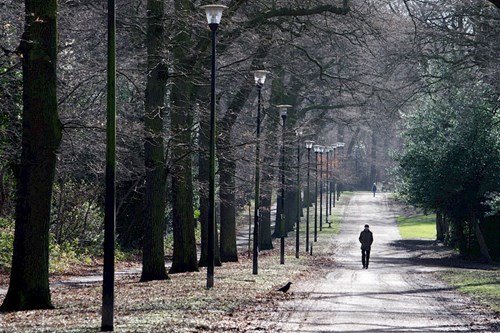
3. Norfolk Heritage Park
When it opened in 1848, Norfolk Heritage Park was one of the country’s first parks to be free to the general public. In 1897 Queen Victoria visited, and was greeted by 50,000 school children singing patriotic songs and hymns. The overall landscape is that of a traditional country estate with extensive rolling grassland, along with two tree-lined avenues (that are particularly impressive during autumn) and some fantastic leafy vistas looking down on the city.
4. Clay Wood
Woodland has been on this site since the days of the medieval deer park when it was known as Spring Wood. By the 1700s the deer park had been dissolved and divided into small farms and wooded areas, and this section was leased by Joseph Clay – giving it its present name. The ancient wood is now a peaceful home to a variety of wildlife.
5. Cholera Monument Grounds
Cholera came to Sheffield in July 1832, and over the course of around four months the waterborne disease claimed the lives of 402 people in the city. 339 of these victims are buried here, in a plot of land provided by the Duke of Norfolk. To reduce the spread of the disease, burials were hasty – and other than that of Master Cutler John Blake, the graves were left unmarked. Renowned 19th century poet James Montgomery laid the foundation stone for the neo-gothic pinnacle that commemorates the dead, while a cobbled artwork installed in 2004 honours them by name. This elevated open space commands a fine view of the city nestled between hills.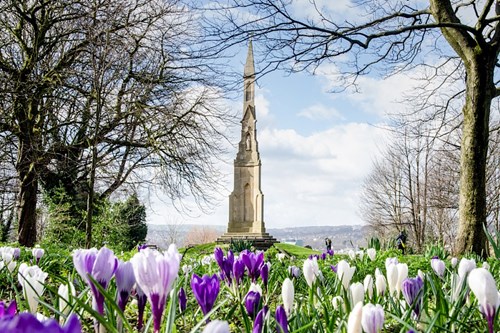
6. Shrewsbury Hospital
When Gilbert Talbot the 7th Earl of Shrewsbury died in 1616, he left provision for a hospital that would care for twenty of Sheffield’s poorest people. The hospital (which, at that time, meant hostel or hospice, rather than infirmary) originally opened in 1673 close to the current Park Square roundabout. In the 1820s it was rebuilt in the fashionable gothic style of the day at this site – directly opposite what is now the main entrance to the Cholera Monument Grounds. It continues to be used as almshouses today, providing affordable accommodation for local retired people.
7. Sweet Factory
This small stone building, standing on its own next to South Street Park, was originally a non-conformist chapel or Sunday school, before being used as a sweet factory well into the 20th century. The cobbled paths to the side of the building are remnants of the residential streets that stood here in Victorian times.
8. Park Hill
Look to the right: that sweeping concrete structure is Park Hill. The iconic, brutalist-style flats opened in 1961, to replace overcrowded and unsanitary Victorian back-to-back housing. Its architects based their design on the idea of “streets in the sky”, recreating the community feel of the previous streets by allowing room for milk floats on the decks and by rehousing neighbours next to one another. Park Hill is Europe’s largest listed building, recognised as one of the country’s most innovative post-second world war social housing projects. Developers are currently renovating the estate, block by block.
9. Old Queens Head
Look down to the left, meanwhile, to spot another significant, listed building, from an entirely different era. The Old Queens Head is thought to be Sheffield’s oldest surviving domestic building, dating back to the 15th century. This historic timber-framed pub, next to Sheffield Interchange, is named after Mary Queen of Scots, who went on to be beheaded after her time in Sheffield.
40 Pond Hill, S1 2BG
10. Sheffield Cathedral
Following the tram bridge into the city centre, the trail then passes the former site of Sheffield Castle on the right down Haymarket, before reaching its final destination. Sheffield Castle also hosted Mary Queen of Scots for a period, and was demolished after the Civil War. Since the demolition of 1960s Castle Market, the site is undergoing redevelopment. Onwards to Sheffield Cathedral, where a church has stood since the 12th century, when the modern town was founded. Once inside the cathedral, visit the 4th and 6th Earls of Shrewsbury’s opulent tombs in the chapel, learn about the mystery of the coffins missing from their family crypt, and admire the stained glass windows and lantern tower. Refuel at the cafe as you reflect on the centuries’ worth of history revealed on the Norfolk Heritage Trail.
Church Street, S1 1HA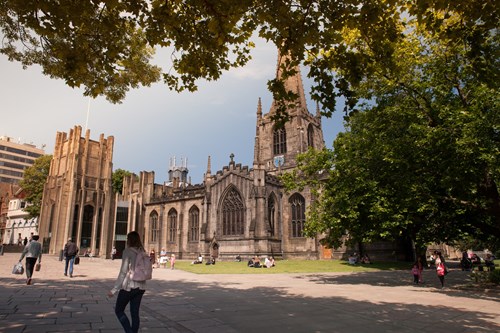
The Norfolk Heritage Trail was originally developed by Sheffield and Rotherham Wildlife Trust. This version has been developed with support from Inmotion.